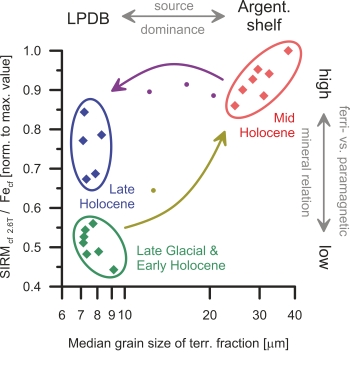South AmericaÂīs Holocene environmental changes and the specific grains of magnetite
Dissertationskolloquium
Veranstalter: Sebastian Razik
Ort: GEO-GebÃĪude, Raum 1550 (HÃķrsaal)Beginn: 07.11.2014 18:15 Uhr

Dominance variations of terrigenous sediment sources and of environmental conditions (i.e., Argentinean shelf vs. La Plata Drainage Basin (LPDB)) revealed due to different magnetic mineral assemblages deposited off South Brazil (GeoB 6211-2).
Marine sediments act globally as natural archives for various environmental conditions. In this context, the continental margin of SE South America (ca. 20°â55° S) is very sensitive, as it obtains sediments from multiple terrestrial sources, each conveying specific magnetic mineral assemblages due to existent source-rock petrology and respective climatic and weathering conditions. These shelf and slope sediments are distributed by ocean currents, which are under influence of the South American Monsoon System (SAMS) as well as the Southern Westerly Wind Belt (SWWB).
In this PhD thesis, multi-proxy approaches performed on surface and down-core sediment samples (focused on magnetic properties and clastic grain-size distributions, in particular) were used to delineate multiple terrigenous sediment provinces. This enabled the identification of corresponding terrestrial host rocks and made it possible to derive the major fluvial and eolian transport processes with links to the tropospheric as well as marine circulation patterns: The most important sediment sources are the La Plata Drainage Basin and the Pampas, while their sediments are transported to the continental shelf by the La Plata River, and by the southern westerly winds or by coastal wave erosion, respectively (see Fig.). Due to the different origin of sediments deposited in the vicinity of the Subtropical Shelf Front (STSF; hydrographic barrier between northward and southward flowing water masses off South Brazil), for the first time relative meridional shifts of the STSF were identified. Thus, during the Mid Holocene (8â4 cal kyr BP) it was proven that the STSF reached its northernmost position during the last 14 cal kyr. As for the first time the SWWB and the SAMS were taken into joint consideration, it could be deduced that the northward shift of the STSF was likely caused by a strengthened SWWB and a relatively weak SAMS, causing a more northward penetration of the Subantarctic Shelf Water.
This study reveals that the performed enviromagnetic-based approaches are sensitive and efficient for provenance studies in regions with multiple sediment sources, as well as different sediment transport mechanisms. The multi-proxy methods performed in this thesis have a large potential to answer challenging questions with respect to terrestrial, limnic, fluvial, and marine environments worldwide.
zurÞck

